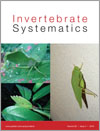IS15033Integrative systematic studies on tardigrades from Antarctica identify new genera and new species within Macrobiotoidea and Echiniscoidea
Tardigrades are one of the main component of Antarctic fauna in terms of abundance, distribution and diversity. Antarctic tardigrades from Dronning Maud Land and Victoria Land, together with specimens from Italy and Greenland, were analyzed from morphological and molecular points of view. These analyses led to the erection of two new genera and the description of two new species.




